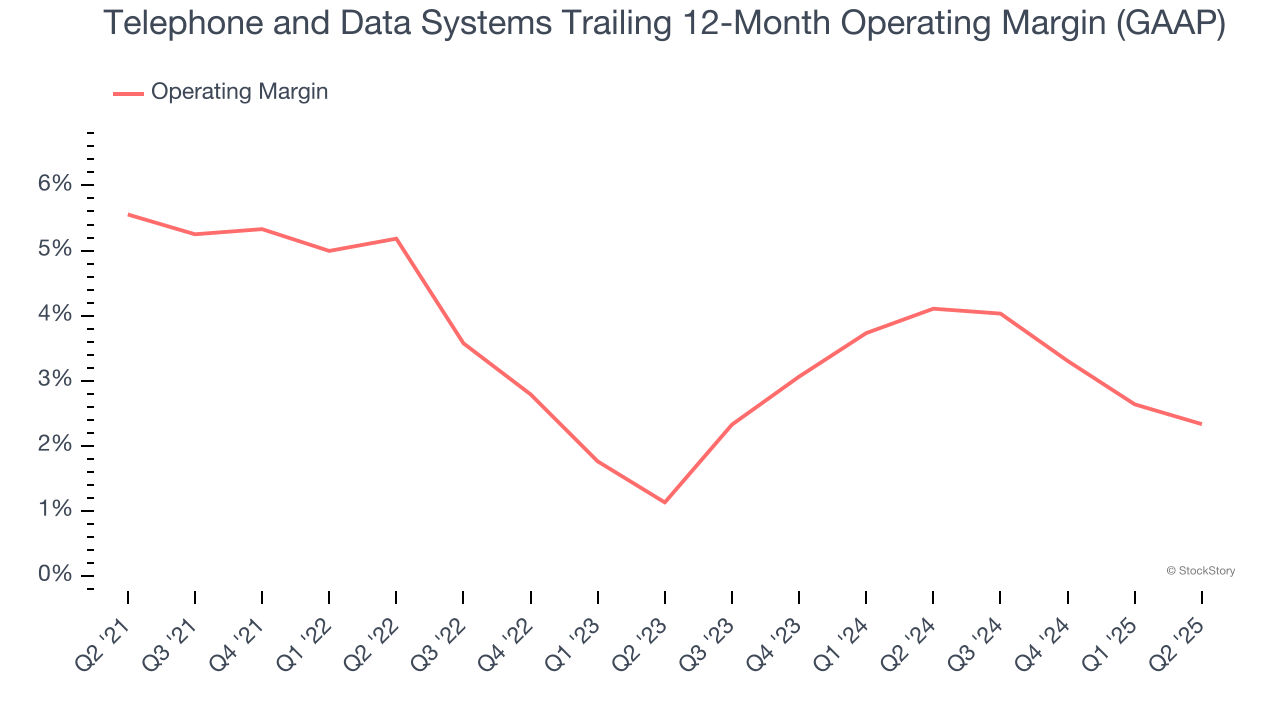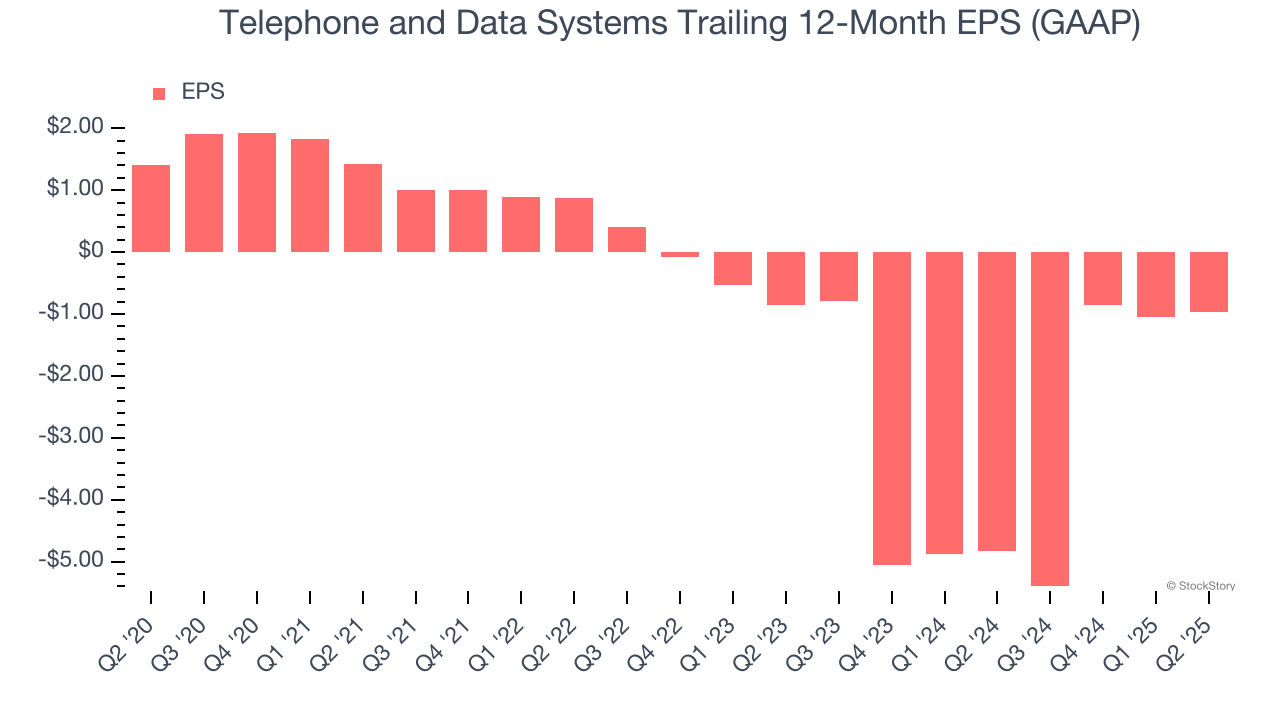
Telecommunications services provider Telephone and Data Systems (NYSE: TDS) beat Wall Street’s revenue expectations in Q2 CY2025, but sales fell by 4.2% year on year to $1.19 billion. Its GAAP loss of $0.05 per share was significantly below analysts’ consensus estimates.
Is now the time to buy Telephone and Data Systems? Find out by accessing our full research report, it’s free.
Telephone and Data Systems (TDS) Q2 CY2025 Highlights:
- Revenue: $1.19 billion vs analyst estimates of $1.17 billion (4.2% year-on-year decline, 1.5% beat)
- EPS (GAAP): -$0.05 vs analyst estimates of $0.01 (significant miss)
- Adjusted EBITDA: $219 million vs analyst estimates of $324.5 million (18.5% margin, 32.5% miss)
- Operating Margin: 3.4%, down from 4.5% in the same quarter last year
- Free Cash Flow Margin: 22.3%, up from 15% in the same quarter last year
- Market Capitalization: $4.45 billion
"TDS has made significant progress on its strategic priorities," said Walter Carlson, TDS President and CEO.
Company Overview
Operating primarily through its majority-owned subsidiary UScellular and wholly-owned TDS Telecom, Telephone and Data Systems (NYSE: TDS) provides wireless, broadband, video, and voice communications services to 4.6 million wireless and 1.2 million broadband customers across the United States.
Revenue Growth
Examining a company’s long-term performance can provide clues about its quality. Any business can put up a good quarter or two, but many enduring ones grow for years.
With $4.80 billion in revenue over the past 12 months, Telephone and Data Systems is one of the larger companies in the business services industry and benefits from a well-known brand that influences purchasing decisions. However, its scale is a double-edged sword because it’s harder to find incremental growth when you’ve penetrated most of the market. For Telephone and Data Systems to boost its sales, it likely needs to adjust its prices, launch new offerings, or lean into foreign markets.
As you can see below, Telephone and Data Systems’s revenue declined by 1.5% per year over the last five years, a poor baseline for our analysis.

Long-term growth is the most important, but within business services, a half-decade historical view may miss new innovations or demand cycles. Telephone and Data Systems’s recent performance shows its demand remained suppressed as its revenue has declined by 5% annually over the last two years. 
This quarter, Telephone and Data Systems’s revenue fell by 4.2% year on year to $1.19 billion but beat Wall Street’s estimates by 1.5%.
Looking ahead, sell-side analysts expect revenue to decline by 1.6% over the next 12 months. While this projection is better than its two-year trend, it’s tough to feel optimistic about a company facing demand difficulties.
Unless you’ve been living under a rock, it should be obvious by now that generative AI is going to have a huge impact on how large corporations do business. While Nvidia and AMD are trading close to all-time highs, we prefer a lesser-known (but still profitable) stock benefiting from the rise of AI. Click here to access our free report one of our favorites growth stories.
Operating Margin
Telephone and Data Systems was profitable over the last five years but held back by its large cost base. Its average operating margin of 3.7% was weak for a business services business.
Analyzing the trend in its profitability, Telephone and Data Systems’s operating margin decreased by 3.2 percentage points over the last five years. Telephone and Data Systems’s performance was poor no matter how you look at it - it shows that costs were rising and it couldn’t pass them onto its customers.

This quarter, Telephone and Data Systems generated an operating margin profit margin of 3.4%, down 1.2 percentage points year on year. This reduction is quite minuscule and indicates the company’s overall cost structure has been relatively stable.
Earnings Per Share
Revenue trends explain a company’s historical growth, but the long-term change in earnings per share (EPS) points to the profitability of that growth – for example, a company could inflate its sales through excessive spending on advertising and promotions.
Sadly for Telephone and Data Systems, its EPS declined by 21.9% annually over the last five years, more than its revenue. This tells us the company struggled because its fixed cost base made it difficult to adjust to shrinking demand.

Diving into the nuances of Telephone and Data Systems’s earnings can give us a better understanding of its performance. As we mentioned earlier, Telephone and Data Systems’s operating margin declined by 3.2 percentage points over the last five years. This was the most relevant factor (aside from the revenue impact) behind its lower earnings; interest expenses and taxes can also affect EPS but don’t tell us as much about a company’s fundamentals.
Like with revenue, we analyze EPS over a shorter period to see if we are missing a change in the business.
For Telephone and Data Systems, its two-year annual EPS declines of 6.8% show it’s still underperforming. These results were bad no matter how you slice the data.
In Q2, Telephone and Data Systems reported EPS at negative $0.05, up from negative $0.13 in the same quarter last year. Despite growing year on year, this print missed analysts’ estimates. Over the next 12 months, Wall Street is optimistic. Analysts forecast Telephone and Data Systems’s full-year EPS of negative $0.97 will reach break even.
Key Takeaways from Telephone and Data Systems’s Q2 Results
It was good to see Telephone and Data Systems narrowly top analysts’ revenue expectations this quarter. On the other hand, its EPS missed. Overall, this quarter could have been better. The stock remained flat at $39 immediately after reporting.
Is Telephone and Data Systems an attractive investment opportunity right now? If you’re making that decision, you should consider the bigger picture of valuation, business qualities, as well as the latest earnings. We cover that in our actionable full research report which you can read here, it’s free.





